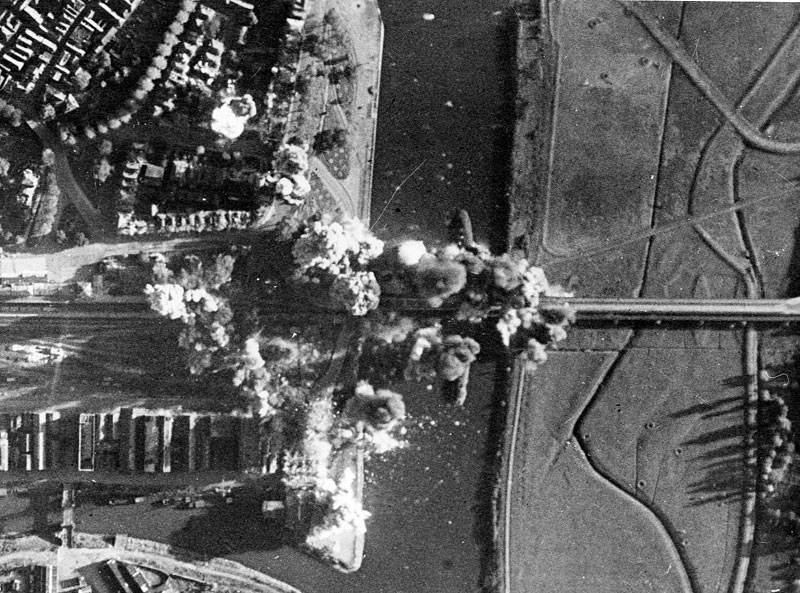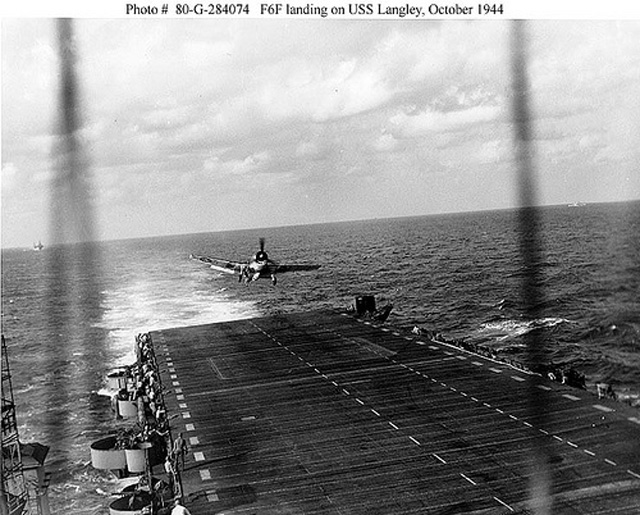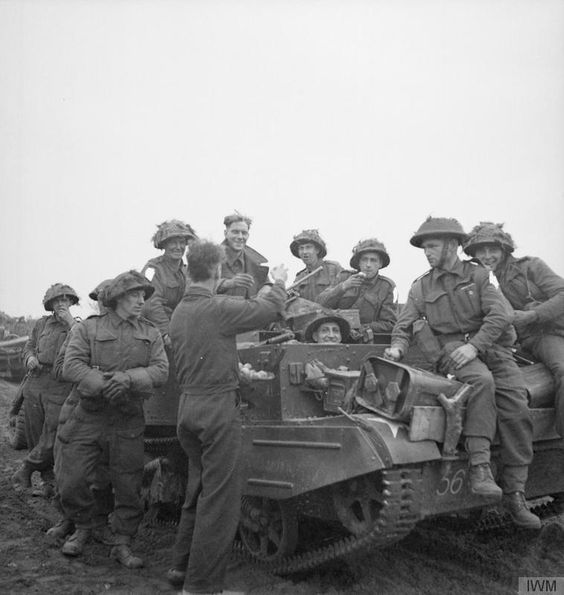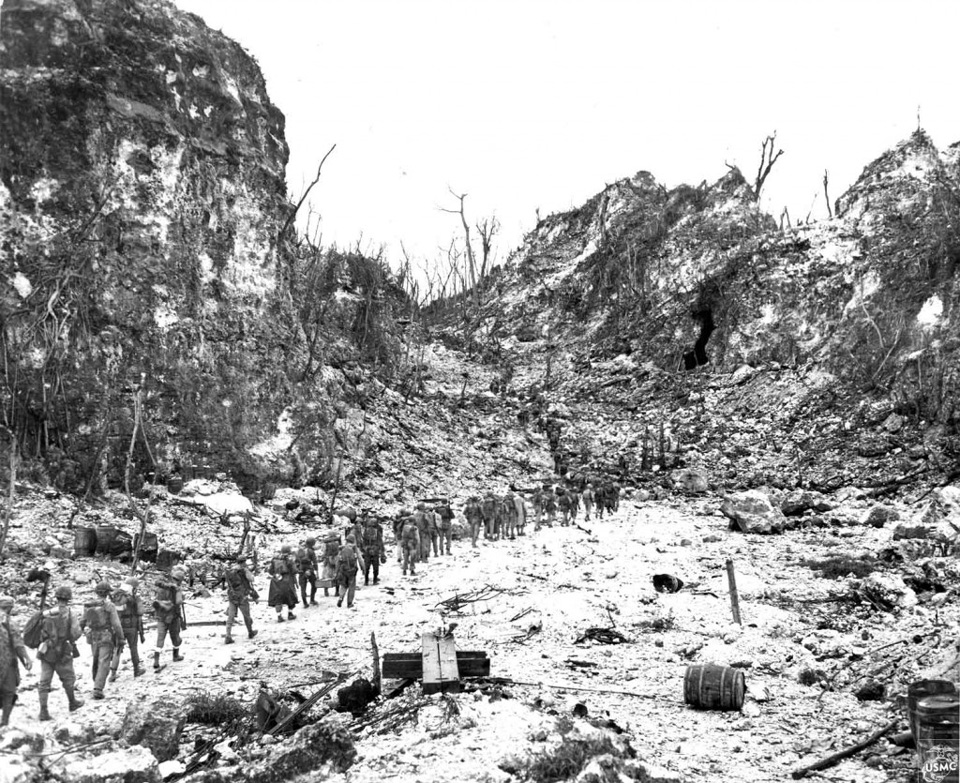Air Operations, CBI
BURMA- 28 10th Air Force P-47s attack Man Naung and Tawbon, Japanese Armytroops near Pinhe, and targets of opportunity around Momauk.
- 12 341st Medium Bomb Group B-25s attack a ferry at Kunlong.
- 38 14th Air Force P-51s and P-40s attack numerous targets in southern and east-central China and shipping along the northern French Indochina coast.
- A 74th Fighter Squadron P-51 downs a Ki-44 'Tojo' fighter over the airfield at Amoy at 1406 hours.
Air Operations, East Indies
- Preceded by 16 35th Fighter Group P-47s, 11 V Fighter Command and 49th Fighter Group P-38s, 58 22nd, 43rd, and 90th Heavy Bomb group B-24s, and 49 XIII Bomber Command B-24s and 868th Heavy Bomb Squadron SB-24s mount the largest attack of the war against the airfield and oil refineries at Balikpapan, Borneo. The V Fighter Command and 49th Fighter Group P-38s and 35th Fighter Group P-47s down 18 Japanese Army fighters over Borneo between 1030 and 1115 hours, resulting in no oppostion against the bombers. Four B-24s and one P-38 are lost.
- V Bomber Command B-25s and FEAF P-38s attack Djailolo, the Hate Tobako airfield, the Kaoe airfield on Halmahera, and Wasile Bay while P-47s attack Liang on Amboina.
Air Operations, Europe
RAF BOMBER COMMANDDaylight Ops:
Minor Ops:
- 4 Hudsons and 3 Stirlings are on Resistance operations, and there are 2 Rangere patrols and 3 RCM sorties.
- There are no losses.
Minor Ops:
- 49 Mosquitos are sent to Cologne, 6 each to Aschaffenburg and Pforzheim, 5 to Duisburg and 2 to Düsseldorf, and there is 1 Liberator on an RCM sortie.
- There are no losses.
ITALY:
- 12th Air Force medium bombers and many fighter-bombers are grounded by bad weather, but XII Fighter Command fighter-bombers are able to provide direct support for elements of the US 5th Army.
ITALY:
- Nearly 170 15th Air Force B-17s and B-24s attack rail bridges and four marshalling yards throughout northern Italy, but 350 other heavy bombers abort due to bad weather.
Air Operations, New Guinea
- V Bomber Command B-25s and A-20s attack the airfield at Urarom Airdrome.
- A-20s attack the Sarmi area.
Air Operations, Pacific
- The oil refineries at Balikpapen are devastated by a US raid by B-24 bombers. Oil is one of Japan's most threatened raw materials. Prior to the war it imported nearly 80 percent of its oil supplies, around 60 percent of that coming from the US. The Balikpapen refinery alone produces 40 percent of Japan's oil imports at this stage of the war.
- Over the next 5 days the US continues to demonstrate its air superiority in a massive air campaign against the island of Formosa. During one action on the 13th, 124 Japanese fighters are shot down in a massive aerial dogfight. More that 95 further aircraft are destroyed on the ground. US losses are 22 aircraft. The total Japanese losses in the Formosa-Ryukyus-Luzon area at the end of the 5 days are 350 aircraft destroyed on the ground and 596 shot down. In addition, more than 70 Japanese cargo, oiler and escort ships are sunk.
Air Operations, Ryukyus
- Despite bad weather throughout the region, US carrier aircraft from Task Force 38 mount 1,396 effective sorties against Okinawa and other islands in the Ryukyus. Japanese air strength is severely depleted and airfields are severely damaged. Full photographic coverage Okinawa’s defenses is obtained, and strike aircraft are credited with destroying 4 cargo ships, a submarine tender, 2 midget submarines, 12 torpedo boats, numerous sampans, and countless targets ashore. 21 US aircraft are lost. All but 5 pilots and 4 crewmen are rescued.
- A VF-19 F6F downs a P1Y 'Galaxy' bomber 30 miles from Task Force 38 at 0625 hours.
- VF-29 F6Fs down 2 P1Y 'Galaxy' bombers at sea at 0650 and 0712, respectively.
- A VF-11 F6F downs a D3A 'Val' dive bomber at sea at 0830 hours. VF-27, VF-14, VF-15, and VF-51 F6Fs, and a VT-19 TBM crew down 1 D3A 'Val' dive bomber, 2 D4Y 'Judy' dive bombers, and 11 fighters over Okinawa—mostly in the vicinity of the Yontan airfield on Okinawa between 0915 and 1005 hours.
- A VF-13 F6F downs a Ki-61 'Tony' fighter over Okinawa at 1300 hours.
- A VF-14 F6F downs 3 P1Y 'Galaxy' bombers at 1400 hours.
- A VF-22 F6F downs 1 J1N 'Irving' fighter at sea at 1630 hours.
Air Operations, Volcano Islands
14 30th Heavy Bomb Group B-24s based at Saipan attack Iwo Jima and nearby shipping.
[Balkans
Corinth in Greece is taken by British and Greek forces.
[Baltic Sea
U-2331 is lost in an accident during training, the exact circumstances of which are unclear. She is raised and taken to Gotenhafen, but the time submerged had irreparably damaged the boat's systems.
| Class | Type XXIII |
| CO | Oberleutnant zur See Hans-Walter Pahl |
| Location | Baltic, off Hela |
| Cause | Accident |
| Casualties | 16 |
| Survivors | 5 |
Eastern Front
In the northern sector the advance of the 1st Baltic Front reaches the sea north of Memel. Other armies of the same Front on the left flank push on to the Niemen River, on the northeast frontier of East Prussia. In the south 3rd Ukraine Front continues to attack south of Belgrade reaching and cutting the railway from Nish to Belgrade at Velika Plana, a little south of Belgrade. There is a big tank battle at Debrecen in southeastern Hungary. The Germans are pushed back but then counterattack and destroy 3 Russian corps.
FINLANDThe position of the German XIX Mountain Corps is perilous; it faces an envelopment of its right flank by the Soviet CXXVI Light Rifle Corps, an enemy breakthrough toward Luostari and Petsamo, and an envelopment of its left flank by naval infantry. Indeed, German positions along the Srednii Isthmus are battered by a 47,000-round, 90-minute artillery barrage. Following this Soviet naval infantry attack and break through the German lines. To the south, the CXXVI Light Rifile Corps is now west of Luostari, having marched over 45 miles in 72 hours. Meanwhile, the Soviet CXXVII Light Rifle Corps crosses the Petsamo River. There is fierce fighting between the Soviet CXXXI Rifle Corps and the German 6th Mountain Div along the Russian Road.
NORTHERN SECTORPalanga falls to the 51st Army, isolating the 16th and 18th Armies in the Kurland Peninsula and around Riga. The 5th Guards Tank Army also reaches the Baltic coast near Memel as the 43rd Army strikes the XXVIII Corps inside the town. The 2nd Guards Army pushes toward Tilsit.
The 1st, 2nd and 3rd Baltic Fronts launch concentric attacks upon the German units crammed into the Riga defenses. After costly fighting the Soviets are repulsed, enabling the 18th Army to evacuate the bulk of its units to Kurland. Attacks continue throughout the day and finally pierce the outer defenses.
The isolation of Army Group North in the Kurland Peninsula sever a large group of forces from the German line in the east. Hitler's continued insistence that every yard of ground be held condemns the half million men of this army group to a secondary role for the remainder of the war.SOUTHERN SECTOR
The 40th Army pushes the 8th Army and 2nd Hungarian Army back from the Cluj region. West of Cluj, the 6th Tank Army closes upon Debrecen. However, a ferocious counterattack encircles a large part of the army near the town.
Petrovac falls to units of the 57th Army as it consolidates its hold across the Belgrade-Nis railway.
[Italy
The US II Corps is still continuing its attack in the direction of Bologna, but the rugged terrain and the worsening weather help the vigorous German defense. There is little result either in the Monterumicini sector, where the 34th Div has been engaged for some days, or toward Livergnano, or in the vicinity of the Monte delle Formiche. In the eastern sector the German defense along the Rubicon comes to an end with the fall of Spaccato to the 10th Indian Div of V Corps. The 46th Div takes longiano and La Crocetta. The 1st Div also gets ready to cross the river at Savignano di Romagna.
[Pacific
- The US submarine Barb (SS-220) sinks the Japanese transport Gokuku Maru northwest of Hirado Jima, Kyushu.
- The US submarine Lapon (SS-260) sinks the Japanese army transport Ejiri Maru (6928t) in South China Sea west of Luzon.
- The Dutch submarine Zwaardvisch sinks the Japanese guardboat Koei Maru southwest of Bawean Island, N.E.I.
Palau Islands
The 1st Marine Div steadily flushes out Japanese defenders from Bloody Nose Ridge. Many of the Japanese are killed when US fire detonates an ammunition dump held within the ridge's cave system.
[Ryukyu Islands
The main American carrier force, TF 38 begins a series of operations with attacks by one of its 4 groups on Onami-Oshima, 2 on Okinawa and the fourth against Sakashima. Many Japanese aircraft are destroyed over the islands but the Japanese fail to find the American ships with their strikes. 10 Japanese merchant vessels are sunk around Okinawa. Among the Japanese ships sunk are the submarine tender Jingei and the transport No. 158.
TF 38 is led by Adm Marc A. Mitscher and includes 11 fleet carriers, 6 light carriers, 6 battleships as well as cruisers and destroyers. Adm William F. Halsey commands 3rd Fleet of which TF 38 is a part.
The war draws nearer to Japan. The US Navy, which commenced the conflict so disastrously at Pearl Harbor, can now deploy at least 1,500 warships, including 80 heavy and light aircraft carriers and 17 battleships. US air forces control the Pacific in every quarter, and the amphibious fleet is immensely powerful.
[United States, Planning
The US Committee of Operations Analysts backs saturation incendiary bombing attacks on Tokyo and 5 other Japanese cities to cripple war production (see February 4, March 9, 1945).
[Western Front
The US 30th Div of XIX Corps makes repeated attacks but fails to reach Bardenberg. The US 1st Div tightens its ring around Aachen and issues an ultimatum to the defenders of the city demanding surrender within 24 hours.
[Images from October 10, 1944
|
|
|
|
|
|





